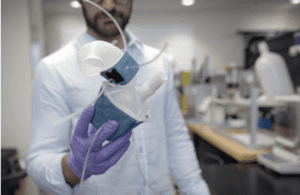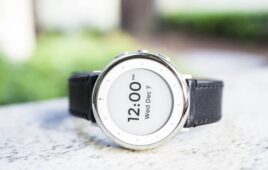
MIT engineers are hoping to help doctors tailor treatments to patients’ specific heart anatomy and function with a custom robotic heart.
[Image courtesy of Melanie Gonick, MIT]
MIT engineers designed the soft robotic models to be patient-specific, which could help clinicians determine the best implant for an individual. It’s possible to control the soft and flexible replica’s actions to mimic a patient’s blood-pumping ability.
To make the device, researchers converted medical images of a patient’s heart into a three-dimensional computer model. Researchers can then 3D print the model using polymer-based ink. The resulting model is a soft, flexible shell that is the exact shape of a patient’s heart. The researchers can also use the method to print a patient’s aorta.
The 3D-printed heart’s pumping action is mimicked using sleeves similar to blood pressure cuffs that wrap around a printed heart and aorta. The underside of each sleeve resembles precisely patterned bubble wrap. When the sleeve is connected to a pneumatic system, researchers can tune the outflowing air to rhythmically inflate the sleeve’s bubbles and contract the heart.
Researchers can also inflate another sleeve surrounding a printed aorta to constrict the vessel. They can tune it to mimic aortic stenosis, a condition in which the aortic valve narrows and causes the heart to exert more energy to pump blood through the body.
“All hearts are different,” Luca Rosalia, a graduate student in the MIT-Harvard Program in Health Sciences and Technology, said in a news release. “There are massive variations, especially when patients are sick. The advantage of our system is that we can recreate not just the form of a patient’s heart, but also its function in both physiology and disease.”
3-D printed heart replicates mechanics and physiology
In one study, the researchers found that for each 3D-printed heart, they could accurately recreate the same heart-pumping pressures and flows that were previously measured in each respective patient.
“Being able to match the patients’ flows and pressures was very encouraging,” said Ellen Roche, a co-author of the study and MIT mechanical engineering professor. “We’re not only printing the heart’s anatomy, but also replicating its mechanics and physiology. That’s the part that we get excited about.”
The MIT research team wanted to replicate some of the interventions that some patients underwent to see if the printed heart and vessel responded similarly. For example, some patients received valve implants to widen the aorta, so Roche and her colleagues implanted similar valves in the printed aortas modeled after each patient. When they activated the printed heart to pump, they observed that the implanted valve produced similarly improved flows as in actual patients following their surgical implants.
Identifying ideal treatments
In continuing research, the MIT researchers used an actuated printed heart to compare implants of different sizes to see which would result in the best fit and flow.
“Patients would get their imaging done, which they do anyway, and we would use that to make this system, ideally within the day,” said co-author Christopher Nguyen, a researcher based out of the Cleveland Clinic in Cleveland, Ohio. “Once it’s up and running, clinicians could test different valve types and sizes and see which works best, then use that to implant.”
Ultimately, Roche and the researchers suggest that patient-specific replicas could help develop and identify ideal treatments for individuals with unique and challenging cardiac geometries.
“Designing inclusively for a large range of anatomies, and testing interventions across this range, may increase the addressable target population for minimally invasive procedures,” Roche said.
The research was published in the journal Science Robotics and was supported, in part, by the National Science Foundation, the National Institutes of Health and the National Heart Lung Blood Institute.




